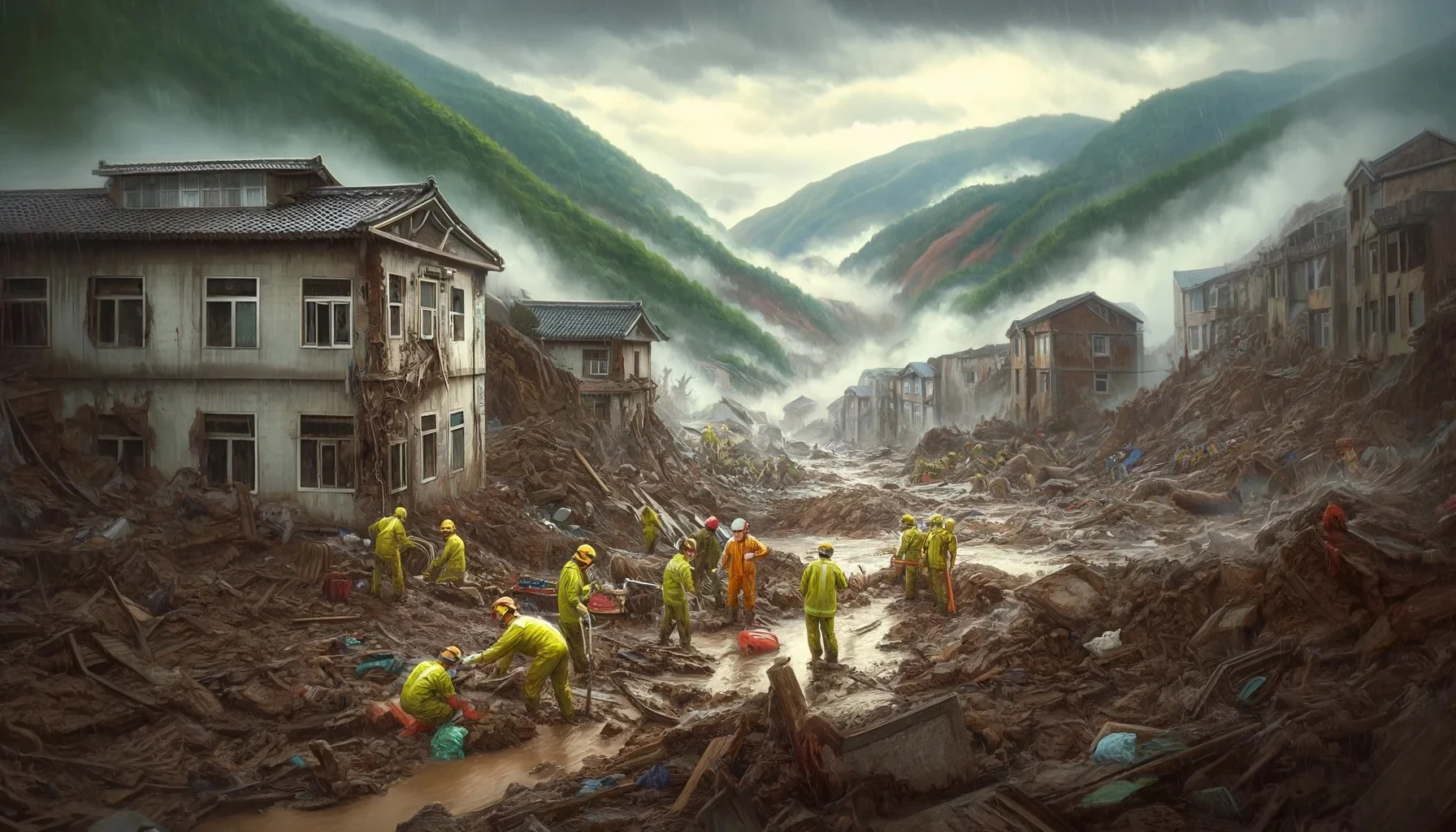
The 2010 Gansu Mudslide
by: The Calamity Calendar Team
August 8, 2010
A Tragic Night Unfolds
In the quiet early hours of August 8, 2010, while most residents of Zhouqu County slept, a catastrophe was brewing in the mountains surrounding their community. Located in the Gannan Tibetan Autonomous Prefecture of China’s Gansu Province, Zhouqu County was no stranger to natural threats. The region’s steep mountainous terrain and ecological vulnerabilities had long posed risks of landslides and flooding. However, nothing could have prepared its inhabitants for the catastrophic mudslide that would soon engulf their homes and forever change their lives.
For days leading up to the disaster, heavy rains drenched the region, saturating the soil beyond its limits. This prolonged downpour, combined with decades of environmental degradation, set the stage for an unprecedented natural calamity. The evening of August 7th brought a relentless barrage of rain, pushing the land to its breaking point.
Environmental Factors at Play
The natural landscape of Zhouqu County had long been predisposed to landslides due to its loose, easily erodible soil. This characteristic made the region particularly vulnerable when combined with heavy rain. However, the area’s vulnerability was exacerbated by human activities such as deforestation and construction, which had destabilized the land over the years. These practices stripped the mountains of their natural vegetation, which normally acts as a stabilizing force, preventing the soil from washing away.
Leading up to the night of the disaster, the region had experienced over 90 millimeters (3.5 inches) of rain, an unusually intense deluge for this period. This unrelenting rain saturated the weakened soil, turning the once-stable slopes into a ticking time bomb.
Thanks for subscribing!
The Night of Devastation
The mudslide struck suddenly, at approximately 12:30 AM on August 8th. Residents awoke to the sound of earth and debris cascading down the mountainside, obliterating everything in its path. Homes were buried under thick layers of mud, trapping families inside with little warning. As dawn broke over Zhouqu County, the extent of the destruction became painfully clear. Large swathes of the county lay buried beneath the debris, and survivors emerged to find their community irreparably changed.
A Herculean Rescue Effort
In the immediate aftermath of the mudslide, rescue operations faced immense challenges. The rugged terrain and persistent rain made accessing the affected areas difficult, hampering efforts to reach those trapped under the rubble. Nevertheless, local authorities and rescue teams quickly mobilized, determined to save as many lives as possible.
By August 9th, thousands of Chinese troops and paramilitary forces had been dispatched to assist with rescue efforts. Heavy machinery was brought in to clear the debris, and rescue workers toiled tirelessly to locate survivors amid the devastation. Despite these efforts, hope faded as the death toll continued to rise.
On August 10th, the Chinese government declared a national day of mourning, a somber recognition of the lives lost in one of the deadliest landslides in recent Chinese history.
The Human Cost
The mudslide left a staggering human toll in its wake. Approximately 1,471 people were confirmed dead, with an additional 294 individuals reported missing. Families were torn apart, and communities shattered by the sudden loss of life.
The mudslide also caused extensive property damage. Over 1,100 homes were destroyed, leaving an estimated 45,000 people displaced and in urgent need of shelter. The economic impact was equally devastating, with direct losses estimated at around 3.1 billion yuan (approximately 456 million USD).
A Call to Action
In the wake of the disaster, the Chinese government mounted a robust response, focusing on providing immediate aid and support to survivors. Temporary shelters and medical facilities were established to care for the displaced, while rescue teams continued their search for survivors amidst the debris.
International aid and support poured in from various countries and organizations, though China largely relied on its resources to manage the crisis. The disaster served as a wake-up call for the Chinese government, prompting a reevaluation of policies concerning land management and disaster preparedness.
Lessons Learned
In the years following the 2010 Zhouqu County Mudslide, further studies have underscored the critical importance of sustainable land management and the growing impact of climate change on weather patterns. The tragedy highlighted the need for improved monitoring and early warning systems to prevent such disasters from occurring again.
The Chinese government has since increased efforts to implement reforestation projects and enhance land management practices, aiming to reduce the risk of similar events in the future. This commitment to environmental conservation and disaster preparedness reflects a growing recognition of the need to protect vulnerable regions and their communities from the devastating effects of natural disasters.
The 2010 Zhouqu County Mudslide stands as a tragic reminder of nature’s power and the devastating consequences of environmental neglect. As China continues to rebuild and learn from this disaster, it serves as a poignant example of the resilience and determination of the human spirit in the face of unimaginable adversity.
Stay in the Loop!
Become a Calamity Insider and get exclusive Calamity Calendar updates delivered straight to your inbox.
Thanks! You're now subscribed.